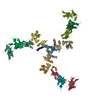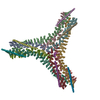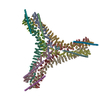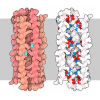[English] 日本語
 Yorodumi
Yorodumi- PDB-7t0o: cryoEM reconstruction of the HIV gp140 in complex with the extrac... -
+ Open data
Open data
- Basic information
Basic information
| Entry | Database: PDB / ID: 7t0o | ||||||
|---|---|---|---|---|---|---|---|
| Title | cryoEM reconstruction of the HIV gp140 in complex with the extracellular domains of CD4 and the adnectin domain of Combinectin. The gp140 and CD4 coordinates from entry 6EDU were rigid body fitted to the EM map along withe the crystal structure of CD4+adnectin | ||||||
 Components Components |
| ||||||
 Keywords Keywords | ANTIVIRAL PROTEIN / Inhibitor / HIV gp140 / CD4 / adnectin | ||||||
| Function / homology |  Function and homology information Function and homology informationhelper T cell enhancement of adaptive immune response / interleukin-16 binding / interleukin-16 receptor activity / maintenance of protein location in cell / T cell selection / MHC class II protein binding / cellular response to granulocyte macrophage colony-stimulating factor stimulus / interleukin-15-mediated signaling pathway / positive regulation of monocyte differentiation / Nef Mediated CD4 Down-regulation ...helper T cell enhancement of adaptive immune response / interleukin-16 binding / interleukin-16 receptor activity / maintenance of protein location in cell / T cell selection / MHC class II protein binding / cellular response to granulocyte macrophage colony-stimulating factor stimulus / interleukin-15-mediated signaling pathway / positive regulation of monocyte differentiation / Nef Mediated CD4 Down-regulation / Alpha-defensins / positive regulation of kinase activity / regulation of T cell activation / T cell receptor complex / extracellular matrix structural constituent / Other interleukin signaling / enzyme-linked receptor protein signaling pathway / Translocation of ZAP-70 to Immunological synapse / Phosphorylation of CD3 and TCR zeta chains / regulation of calcium ion transport / macrophage differentiation / Generation of second messenger molecules / T cell differentiation / PD-1 signaling / positive regulation of protein kinase activity / Binding and entry of HIV virion / coreceptor activity / positive regulation of calcium-mediated signaling / cell surface receptor protein tyrosine kinase signaling pathway / T cell activation / positive regulation of interleukin-2 production / protein tyrosine kinase binding / Vpu mediated degradation of CD4 / calcium-mediated signaling / clathrin-coated endocytic vesicle membrane / transmembrane signaling receptor activity / positive regulation of peptidyl-tyrosine phosphorylation / Downstream TCR signaling / Cargo recognition for clathrin-mediated endocytosis / positive regulation of T cell activation / MHC class II protein complex binding / Clathrin-mediated endocytosis / virus receptor activity / signaling receptor activity / positive regulation of canonical NF-kappaB signal transduction / defense response to Gram-negative bacterium / adaptive immune response / positive regulation of MAPK cascade / positive regulation of viral entry into host cell / positive regulation of ERK1 and ERK2 cascade / cell surface receptor signaling pathway / early endosome / cell adhesion / positive regulation of protein phosphorylation / immune response / membrane raft / endoplasmic reticulum lumen / external side of plasma membrane / lipid binding / endoplasmic reticulum membrane / protein kinase binding / positive regulation of DNA-templated transcription / enzyme binding / signal transduction / protein homodimerization activity / zinc ion binding / identical protein binding / plasma membrane Similarity search - Function | ||||||
| Biological species |  HIV-1 06TG.HT008 (virus) HIV-1 06TG.HT008 (virus) Homo sapiens (human) Homo sapiens (human) | ||||||
| Method | ELECTRON MICROSCOPY / single particle reconstruction / cryo EM / Resolution: 8.7 Å | ||||||
 Authors Authors | Concha, N.O. / William, S.P. / Wenzel, D.L. | ||||||
| Funding support |  United States, 1items United States, 1items
| ||||||
 Citation Citation |  Journal: J Mol Biol / Year: 2022 Journal: J Mol Biol / Year: 2022Title: Novel Bent Conformation of CD4 Induced by HIV-1 Inhibitor Indirectly Prevents Productive Viral Attachment. Authors: David Wensel / Shawn Williams / David P Dixon / Paris Ward / Patti McCormick / Nestor Concha / Eugene Stewart / Xuan Hong / Charles Mazzucco / Shreya Pal / Bo Ding / Christoph Fellinger / Mark Krystal /   Abstract: GSK3732394 is a multi-specific biologic inhibitor of HIV entry currently under clinical evaluation. A key component of this molecule is an adnectin (6940_B01) that binds to CD4 and inhibits ...GSK3732394 is a multi-specific biologic inhibitor of HIV entry currently under clinical evaluation. A key component of this molecule is an adnectin (6940_B01) that binds to CD4 and inhibits downstream actions of gp160. Studies were performed to determine the binding site of the adnectin on CD4 and to understand the mechanism of inhibition. Using hydrogen-deuterium exchange with mass spectrometry (HDX), CD4 peptides showed differential rates of deuteration (either enhanced or slowed) in the presence of the adnectin that mapped predominantly to the interface of domains 2 and 3 (D2-D3). In addition, an X-ray crystal structure of an ibalizumab Fab/CD4(D1-D4)/adnectin complex revealed an extensive interface between the adnectin and residues on CD4 domains D2-D4 that stabilize a novel T-shaped CD4 conformation. A cryo-EM map of the gp140/CD4/GSK3732394 complex clearly shows the bent conformation for CD4 while bound to gp140. Mutagenic analyses on CD4 confirmed that amino acid F202 forms a key interaction with the adnectin. In addition, amino acid L151 was shown to be a critical indirect determinant of the specificity for binding to the human CD4 protein over related primate CD4 molecules, as it appears to modulate CD4's flexibility to adopt the adnectin-bound conformation. The significant conformational change of CD4 upon adnectin binding brings the D1 domain of CD4 in proximity to the host cell membrane surface, thereby re-orienting the gp120 binding site in a direction that is inaccessible to incoming virus due to a steric clash between gp160 trimers on the virus surface and the target cell membrane. | ||||||
| History |
|
- Structure visualization
Structure visualization
| Movie |
 Movie viewer Movie viewer |
|---|---|
| Structure viewer | Molecule:  Molmil Molmil Jmol/JSmol Jmol/JSmol |
- Downloads & links
Downloads & links
- Download
Download
| PDBx/mmCIF format |  7t0o.cif.gz 7t0o.cif.gz | 491.1 KB | Display |  PDBx/mmCIF format PDBx/mmCIF format |
|---|---|---|---|---|
| PDB format |  pdb7t0o.ent.gz pdb7t0o.ent.gz | 405 KB | Display |  PDB format PDB format |
| PDBx/mmJSON format |  7t0o.json.gz 7t0o.json.gz | Tree view |  PDBx/mmJSON format PDBx/mmJSON format | |
| Others |  Other downloads Other downloads |
-Validation report
| Summary document |  7t0o_validation.pdf.gz 7t0o_validation.pdf.gz | 825.7 KB | Display |  wwPDB validaton report wwPDB validaton report |
|---|---|---|---|---|
| Full document |  7t0o_full_validation.pdf.gz 7t0o_full_validation.pdf.gz | 874.5 KB | Display | |
| Data in XML |  7t0o_validation.xml.gz 7t0o_validation.xml.gz | 73.1 KB | Display | |
| Data in CIF |  7t0o_validation.cif.gz 7t0o_validation.cif.gz | 113.5 KB | Display | |
| Arichive directory |  https://data.pdbj.org/pub/pdb/validation_reports/t0/7t0o https://data.pdbj.org/pub/pdb/validation_reports/t0/7t0o ftp://data.pdbj.org/pub/pdb/validation_reports/t0/7t0o ftp://data.pdbj.org/pub/pdb/validation_reports/t0/7t0o | HTTPS FTP |
-Related structure data
| Related structure data |  25581MC  7t0rC M: map data used to model this data C: citing same article ( |
|---|---|
| Similar structure data |
- Links
Links
- Assembly
Assembly
| Deposited unit | 
|
|---|---|
| 1 |
|
- Components
Components
-BG505 SOSIP.664 ... , 4 types, 9 molecules DGIBFJKNR
| #1: Protein | Mass: 72830.398 Da / Num. of mol.: 3 Source method: isolated from a genetically manipulated source Source: (gene. exp.)  HIV-1 06TG.HT008 (virus) / Cell line (production host): Expi293F / Production host: HIV-1 06TG.HT008 (virus) / Cell line (production host): Expi293F / Production host:  Homo sapiens (human) Homo sapiens (human)#2: Protein/peptide | | Mass: 3337.105 Da / Num. of mol.: 1 Source method: isolated from a genetically manipulated source Source: (gene. exp.)  HIV-1 06TG.HT008 (virus) / Cell line (production host): Expi293F / Production host: HIV-1 06TG.HT008 (virus) / Cell line (production host): Expi293F / Production host:  Homo sapiens (human) Homo sapiens (human)#3: Protein/peptide | Mass: 3252.000 Da / Num. of mol.: 2 Source method: isolated from a genetically manipulated source Source: (gene. exp.)  HIV-1 06TG.HT008 (virus) / Cell line (production host): Expi293F / Production host: HIV-1 06TG.HT008 (virus) / Cell line (production host): Expi293F / Production host:  Homo sapiens (human) Homo sapiens (human)#6: Protein/peptide | Mass: 2996.685 Da / Num. of mol.: 3 Source method: isolated from a genetically manipulated source Source: (gene. exp.)  HIV-1 06TG.HT008 (virus) / Cell line (production host): Expi293F / Production host: HIV-1 06TG.HT008 (virus) / Cell line (production host): Expi293F / Production host:  Homo sapiens (human) Homo sapiens (human) |
|---|
-Protein , 2 types, 6 molecules HLMOPQ
| #4: Protein | Mass: 41385.449 Da / Num. of mol.: 3 Source method: isolated from a genetically manipulated source Source: (gene. exp.)  Homo sapiens (human) / Gene: CD4 / Production host: Homo sapiens (human) / Gene: CD4 / Production host:  #5: Protein | Mass: 11959.172 Da / Num. of mol.: 3 Source method: isolated from a genetically manipulated source Details: The native 10th fibronectin type III (10Fn3) domain from human fibronectin was used as the template for construction of novel libraries of Adnectin variants (Wenzel, D., et al. (2017) ...Details: The native 10th fibronectin type III (10Fn3) domain from human fibronectin was used as the template for construction of novel libraries of Adnectin variants (Wenzel, D., et al. (2017) Antimicrobial Agents and Chemotherapy, Vol 61(8), e00508-17, pp 1-19) Source: (gene. exp.)  Homo sapiens (human) / Production host: Homo sapiens (human) / Production host:  |
|---|
-Experimental details
-Experiment
| Experiment | Method: ELECTRON MICROSCOPY |
|---|---|
| EM experiment | Aggregation state: PARTICLE / 3D reconstruction method: single particle reconstruction |
- Sample preparation
Sample preparation
| Component | Name: Ternary complex of the HIV-1 gp140 trimer in complex with the extracellular domains (domains 1-4) of CD4 and an adnectin domain of Combinectin Type: COMPLEX Details: the gp140 trimer at 0.67 mg/ml was mixed with soluble CD4 first, and then with Combinection in a 1.25:1 ratio. The sample was incubated overnight at 4 degC. The sample was concentrated to ...Details: the gp140 trimer at 0.67 mg/ml was mixed with soluble CD4 first, and then with Combinection in a 1.25:1 ratio. The sample was incubated overnight at 4 degC. The sample was concentrated to 35ul before injecting into a Phenomenex 4.6 x 300 mm 3um bead 500Angstroms pore Yara SEC column equilibrated with 20mM Hepes pH7.5, 200 mM KCl, 5mM MgCl2. The complexes were eluted with a flow rate of 0.2 ml/min and fractions collected every 20 seconds into a Thermo-Fisher UV transparent 96-well plates. The absorbance at 280nm was measured for each fraction using a Spectramax plate scanner. The high-molecular weight complex appeared to be comprised of gp140:CD4:Combinectin in a 1:1:1 ratio. The sample used for cryo-EM studies was the single peak fraction of gp140/CD4/Combinectin (0.076 mg/ml) Entity ID: all / Source: MULTIPLE SOURCES | ||||||||||||||||
|---|---|---|---|---|---|---|---|---|---|---|---|---|---|---|---|---|---|
| Molecular weight | Experimental value: NO | ||||||||||||||||
| Buffer solution | pH: 7.5 | ||||||||||||||||
| Buffer component |
| ||||||||||||||||
| Specimen | Conc.: 0.08 mg/ml / Embedding applied: NO / Shadowing applied: NO / Staining applied: NO / Vitrification applied: YES Details: the gp140/CD4/Combinectin (0.076 mg/ml), 3.5uL were applied to Quantifoil 1.2/1.3 Cu 400 mesh grids that had previously been glow discharged for 20 sec using a EasyGlo (20mA, 0.3 mBar). The ...Details: the gp140/CD4/Combinectin (0.076 mg/ml), 3.5uL were applied to Quantifoil 1.2/1.3 Cu 400 mesh grids that had previously been glow discharged for 20 sec using a EasyGlo (20mA, 0.3 mBar). The grids were plunged into liquid ethane using a Vitrobot plunger (chamber set to 4 degC and 80% RH) immediately after blotting from 2.5 to 4 sec | ||||||||||||||||
| Specimen support | Details: glow discharged for 20 sec using a EasyGlo (20mA, 0.3 mBar) Grid material: COPPER / Grid mesh size: 400 divisions/in. / Grid type: Quantifoil R1.2/1.3 | ||||||||||||||||
| Vitrification | Instrument: FEI VITROBOT MARK IV / Cryogen name: ETHANE / Humidity: 100 % / Chamber temperature: 277 K |
- Electron microscopy imaging
Electron microscopy imaging
| Experimental equipment |  Model: Titan Krios / Image courtesy: FEI Company |
|---|---|
| Microscopy | Model: FEI TITAN KRIOS |
| Electron gun | Electron source:  FIELD EMISSION GUN / Accelerating voltage: 300 kV / Illumination mode: FLOOD BEAM FIELD EMISSION GUN / Accelerating voltage: 300 kV / Illumination mode: FLOOD BEAM |
| Electron lens | Mode: BRIGHT FIELD / Nominal defocus max: 3400 nm / Nominal defocus min: 1400 nm |
| Image recording | Average exposure time: 75.7 sec. / Electron dose: 1.022 e/Å2 / Detector mode: COUNTING / Film or detector model: FEI FALCON III (4k x 4k) / Num. of real images: 1078 |
| EM imaging optics | Phase plate: OTHER / Spherical aberration corrector: Cs corrector |
| Image scans | Sampling size: 11 µm / Width: 4096 / Height: 4096 |
- Processing
Processing
| EM software |
| |||||||||||||||||||||||||||
|---|---|---|---|---|---|---|---|---|---|---|---|---|---|---|---|---|---|---|---|---|---|---|---|---|---|---|---|---|
| CTF correction | Type: PHASE FLIPPING AND AMPLITUDE CORRECTION | |||||||||||||||||||||||||||
| Symmetry | Point symmetry: C3 (3 fold cyclic) | |||||||||||||||||||||||||||
| 3D reconstruction | Resolution: 8.7 Å / Resolution method: FSC 0.143 CUT-OFF / Num. of particles: 208485 / Num. of class averages: 3 / Symmetry type: POINT | |||||||||||||||||||||||||||
| Atomic model building | Protocol: RIGID BODY FIT |
 Movie
Movie Controller
Controller






 PDBj
PDBj
















